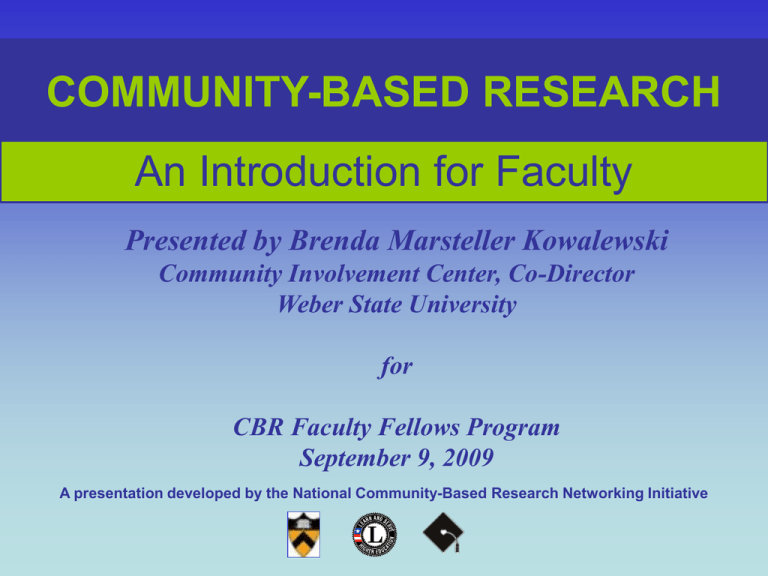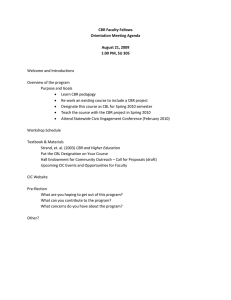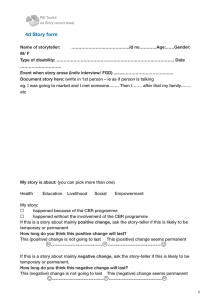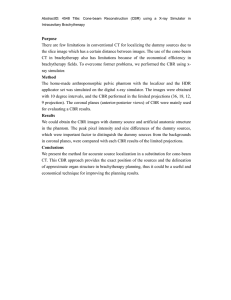COMMUNITY-BASED RESEARCH An Introduction for Faculty Presented by Brenda Marsteller Kowalewski
advertisement

COMMUNITY-BASED RESEARCH An Introduction for Faculty Presented by Brenda Marsteller Kowalewski Community Involvement Center, Co-Director Weber State University for CBR Faculty Fellows Program September 9, 2009 A presentation developed by the National Community-Based Research Networking Initiative CBR: AN OVERVIEW ◘ What is CBR? ◘ Principles of Practice ◘ How does it differ from traditional research? ◘ Why do CBR? ◘ Pedagogical Methods ◘ Benefits & Challenges ◘ What It Takes ◘ Resources CBR: WHAT IS IT? ◘ A collaborative, participatory research process that embraces: Research • Community has information needs • Campus partners have research tools and resources Education • Community has valuable local knowledge & experience • Campus partners have theoretical and large scale perspectives Action • Build organizational and community capacity • Effect policy change CBR: Definition “CBR is a partnership of students, faculty, and community members who collaboratively engage in research with the purpose of solving a pressing community problem or affecting social change” (Strand, et al., 2003). CBR: Principles of CBR • CBR is a collaborative enterprise between researchers and community members. • CBR involves the democratization of knowledge • CBR has as its goal social action and social change for the purpose of achieving social justice (Strand et al., 2003: p. 8). CBR: Collaboration • research with and for the community. • community partners should be working with students and professors at every stage in the research process. CBR: Democratization of Knowledge • knowledge brought to the project by all partners involved is equally valued • multiple research methods are used • user friendly approaches to the dissemination of knowledge are provided • conventional assumptions about knowledge itself are challenged CBR: Social Change for Social Justice • produce information that can be used to bring about needed change • findings of the research or the process itself might contribute to social change CBR: Vs. Traditional Research See handout. Table: Traditional Research vs. CBR See page 9 in text. CBR: WHY DO IT? ◘ Complex social problems ill-suited to “outside expert” research alone ◘ Impact community capacity ◘ Build long-term relationship with community partners ◘ Effective method of teaching and learning for all participants ◘ The ultimate form of servicelearning? Service-Learning: A Balanced Approach CBR: (Furco, 2006) FOCUS Service Learning PRIMARY INTENDED BENEFICIARY Recipient Provider Service-Learning Community Service Volunteerism Field Education Internships 11 CBR: Ultimate S-L Experience • The quality of service-learning is enhanced through CBR in that it offers the most opportunities for: – collaboration – direct application of course content – potential for social change CBR: PEDAGOGICAL METHODS ◘ Course-based options model ◘ CBR-based semester courses ◘ Long-term, course-based projects ◘ Interdisciplinary, multi-course collaborative projects CBR: BENEFITS ◘ Community Access to faculty expertise Organizational capacity building Policy change ◘ Students Develop new skills Improve existing skills Connect classroom learning with real-world application ◘ Faculty Enhanced teaching credentials New venues for publishing and presenting Positively impact students and community CBR: CHALLENGES ◘ Unpredictability ◘ Calendar conflicts ◘ Role confusion ◘ Participant compensation/ recognition CBR: WHAT DOES IT TAKE? ◘ Time ◘ Long-term vision ◘ Communication ◘ Flexibility ◘ Willingness to develop research process with community input CBR: RESOURCES ◘ National Community-Based Research Networking Initiative www.cbrnet.org ◘ CBR Course and Project Database www.bonner.org/campus/cbr/profiles.taf ◘Campus-Community Partnerships for Health www.ccph.info ◘ Community-Based Research & Higher Education: Principles & Practices Strand, Marullo, Cutforth, et. al.


